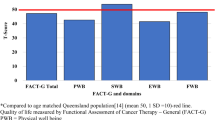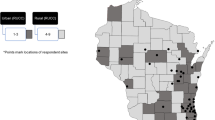Abstract
Purpose
The 2016–2020 Utah Comprehensive Cancer Prevention and Control Plan prioritized strategies to address cancer survivorship experiences. In this paper we present estimates for nine indicators evaluating these priorities, trends over time, and assess disparities in survivorship experiences across demographic subgroups.
Methods
We surveyed a representative sample of Utah cancer survivors diagnosed between 2012 and 2019 with any reportable cancer diagnosis. We calculated weighted percentages and 95% confidence intervals (CI) for each indicator. We assessed change over time using a test for trend across survey years in a logistic regression model and used Rao-Scott F-adjusted chi-square tests to test the association between demographic characteristics and each survivorship indicator.
Results
Most of the 1,793 respondents (93.5%) reported their pain was under control, 85.7% rated their overall health as good, very good, or excellent, but 46.5% experienced physical, mental, or emotional limitations. Only 1.7% of survivors aged 75 or older were current smokers, compared to 5.8% of 65–74-year-olds and 7.9% of survivors aged 55–74 (p < 0.006). No regular physical activity was reported by 20.6% and varied by survivor age and education level. The proportion who received a survivorship care plan increased from 34.6% in 2018 to 43.0% in 2021 (p = 0.025). However, survivors under age 55 were significantly less likely to receive a care plan than older survivors.
Conclusion
This representative survey of cancer survivors fills a gap in understanding of the cancer survivorship experience in Utah. Results can be used to evaluate and plan additional interventions to improve survivorship quality of life.


Similar content being viewed by others
Data availability
The datasets generated during and/or analyzed during the current study are not publicly available due to privacy restrictions.
References
Miller KD, Nogueira L, Mariotto AB, Rowland JH, Yabroff KR, Alfano CM et al (2019) Cancer treatment and survivorship statistics, 2019. CA Cancer J Clin 69(5):363–385. https://doi.org/10.3322/caac.21565
de Moor JS, Mariotto AB, Parry C, Alfano CM, Padgett L, Kent EE et al (2013) Cancer survivors in the United States: prevalence across the survivorship trajectory and implications for care. Cancer Epidemiol Biomark Prev 22(4):561–570. https://doi.org/10.1158/1055-9965.Epi-12-1356
Jemal A, Ward EM, Johnson CJ, Cronin KA, Ma J, Ryerson B et al (2017) Annual report to the nation on the status of cancer, 1975–2014, featuring survival. J Natl Cancer Inst. https://doi.org/10.1093/jnci/djx030
National cancer institute: cancer statistics: about cancer. https://www.cancer.gov/about-cancer/understanding/statistics (2020). Accessed 21 January 2022
Centers for disease control and prevention: national comprehensive cancer control program priorities. https://www.cdc.gov/cancer/ncccp/priorities/index.htm (2021). Accessed 18 March 2022
Rohan EA, Miller N, Bonner F 3rd, Fultz-Butts K, Pratt-Chapman ML, Alfano CM et al (2018) Comprehensive cancer control: promoting survivor health and wellness. Cancer Causes Control 29(12):1277–1285. https://doi.org/10.1007/s10552-018-1107-z
Utah cancer action network: Utah cancer action network home page. https://www.utahcancercoalition.org Accessed 12 December 2022
Utah cancer action network (2016) 2016–2020 Utah comprehensive cancer prevention and control plan
US Department of health and human services (DHHS): Healthy people 2020. https://www.healthypeople.gov/2020/topics-objectives/topic/cancer/objectives Accessed 27 August 2020
Utah department of health: Utah small health statistical areas. https://gis.utah.gov/data/health/health-small-statistical-areas/ (2018). Accessed 17 June 2022
Utah department of health: Utah behavioral risk factor surveillance system data. https://ibis.health.utah.gov/ibisph-view/ (2018). Accessed 17 June 2022
Dillman DA (2017) The promise and challenge of pushing respondents to the web in mixed-mode surveys. Survey Methodol 43(1):1
National cancer institute: what is HINTS? https://hints.cancer.gov Accessed 7 April 2022
Centers for disease control and prevention: behavioral risk factor surveillance system survey. https://www.cdc.gov/brfss/index.html (2014). Accessed 18 March 2022
Pierannunzi C, Hu SS, Balluz L (2013) A systematic review of publications assessing reliability and validity of the behavioral risk factor surveillance system (BRFSS), 2004–2011. BMC Med Res Methodol 13(1):49. https://doi.org/10.1186/1471-2288-13-49
Hicks W, Cantor D (2011) Health information national trends survey 4 (HINTS 4) cycle 1 cognitive interviewing report. Westat, Rockville
Cantor D, Coa K, Crystal-Mansour S, Davis T, Dipko S, Sigman R (2009) Health information national trends survey (HINTS) 2007 final report. Westat, Rockville
U.S. department of agriculture: rural-urban continuum codes. https://www.ers.usda.gov/data-products/rural-urban-continuum-codes/ (2013). Accessed 17 June 2022
Gallaway MS, Glover-Kudon R, Momin B, Puckett M, Lunsford NB, Ragan KR et al (2019) Smoking cessation attitudes and practices among cancer survivors—United States, 2015. J Cancer Surviv 13(1):66–74. https://doi.org/10.1007/s11764-018-0728-2
Bureau of health promotion tobacco prevention and control program: current cigarette smoking by age group, Utah adults aged 18 and older, 2020. https://ibis.health.utah.gov/ibisph-view/indicator/view/CigSmokAdlt.Age.html (2022). Accessed 5 May 2022
Ehrenzeller MF, Mayer DK, Goldstein A (2018) Smoking prevalence and management among cancer survivors. Oncol Nurs Forum 45(1):55–68. https://doi.org/10.1188/18.Onf.55-68
Blair CK, Robien K, Inoue-Choi M, Rahn W, Lazovich D (2016) Physical inactivity and risk of poor quality of life among elderly cancer survivors compared to women without cancer: the Iowa women’s health study. J Cancer Surviv 10(1):103–112. https://doi.org/10.1007/s11764-015-0456-9
Rees-Punia E, Patel AV, Nocera JR, Chantaprasopsuk S, Demark-Wahnefried W, Leach CR et al (2020) Self-reported physical activity, sitting time, and mental and physical health among older cancer survivors compared with adults without a history of cancer. Cancer 127(1):115–123. https://doi.org/10.1002/cncr.33257
Knight TG, Deal AM, Dusetzina SB, Muss HB, Choi SK, Bensen JT et al (2018) Financial toxicity in adults with cancer: adverse outcomes and noncompliance. J Oncol Pract 14(11):e665–e673. https://doi.org/10.1200/jop.18.00120
Fowler B, Ding Q, Pappas L, Wu YP, Linder L, Yancey J et al (2018) Utah cancer survivors: a comprehensive comparison of health-related outcomes between survivors and individuals without a history of cancer. J Cancer Educ 33(1):214–221. https://doi.org/10.1007/s13187-016-1098-y
Centers for disease control and prevention: vital signs: Hispanic health. https://www.cdc.gov/vitalsigns/hispanic-health/index.html (2015). Accessed 11 January 2023
Miller KD, Ortiz AP, Pinheiro PS, Bandi P, Minihan A, Fuchs HE et al (2021) Cancer statistics for the US Hispanic/Latino population, 2021. CA Cancer J Clin 71(6):466–487. https://doi.org/10.3322/caac.21695
Kronenfeld JP, Graves KD, Penedo FJ, Yanez B (2021) Overcoming disparities in cancer: a need for meaningful reform for Hispanic and Latino cancer survivors. Oncologist 26(6):443–452. https://doi.org/10.1002/onco.13729
Bharmal N, Pitkin Derose K, Felician M, Weden MM (2015) Understanding the upstream social determinants of health: working paper. RAND Health
Joshy G, Thandrayen J, Koczwara B, Butow P, Laidsaar-Powell R, Rankin N et al (2020) Disability, psychological distress and quality of life in relation to cancer diagnosis and cancer type: population-based Australian study of 22,505 cancer survivors and 244,000 people without cancer. BMC Med 18(1):372. https://doi.org/10.1186/s12916-020-01830-4
Underwood JM, Rim SH, Fairley TL, Tai E, Stewart SL (2012) Cervical cancer survivors at increased risk of subsequent tobacco-related malignancies, United States 1992–2008. Cancer Causes Control 23(7):1009–1016. https://doi.org/10.1007/s10552-012-9957-2
Reeve BB, Potosky AL, Smith AW, Han PK, Hays RD, Davis WW et al (2009) Impact of cancer on health-related quality of life of older Americans. J Natl Cancer Inst 101(12):860–868. https://doi.org/10.1093/jnci/djp123
Leach CR, Bellizzi KM, Hurria A, Reeve BB (2016) Is it my cancer or am i just getting older?: impact of cancer on age-related health conditions of older cancer survivors. Cancer 122(12):1946–1953. https://doi.org/10.1002/cncr.29914
Weaver KE, Forsythe LP, Reeve BB, Alfano CM, Rodriguez JL, Sabatino SA et al (2012) Mental and physical health-related quality of life among U.S. cancer survivors: population estimates from the 2010 national health interview survey. Cancer Epidemiol Biomark Prev 21(11):2108–17. https://doi.org/10.1158/1055-9965.Epi-12-0740
Ness KK, Gurney JG, Zeltzer LK, Leisenring W, Mulrooney DA, Nathan PC et al (2008) The impact of limitations in physical, executive, and emotional function on health-related quality of life among adult survivors of childhood cancer: a report from the childhood cancer survivor study. Arch Phys Med Rehabil 89(1):128–136. https://doi.org/10.1016/j.apmr.2007.08.123
US department of health and human services (DHHS): healthy people 2030. https://health.gov/healthypeople Accessed 20 January 2022
Mols F, Tomalin B, Pearce A, Kaambwa B, Koczwara B (2020) Financial toxicity and employment status in cancer survivors: a systematic literature review. Support Care Cancer 28(12):5693–708. https://doi.org/10.1007/s00520-020-05719-z
Warner EL, Millar MM, Orleans B, Edwards SL, Carter ME, Vaca Lopez PL et al (2022) Cancer survivors’ financial hardship and their caregivers’ employment: results from a statewide survey. J Cancer Surviv. https://doi.org/10.1007/s11764-022-01203-1
Unger JM, Vaidya R, Hershman DL, Minasian LM, Fleury ME (2019) Systematic review and meta-analysis of the magnitude of structural, clinical, and physician and patient barriers to cancer clinical trial participation. J Natl Cancer Inst 111(3):245–255. https://doi.org/10.1093/jnci/djy221
Murthy VH, Krumholz HM, Gross CP (2004) Participation in cancer clinical trials: race-, sex-, and age-based disparities. JAMA 291(22):2720–2726. https://doi.org/10.1001/jama.291.22.2720
Perni S, Moy B, Nipp RD (2021) Disparities in phase 1 cancer clinical trial enrollment. Cancer 127(23):4464–4469. https://doi.org/10.1002/cncr.33853
Fong AJ, Evens AM, Bandera EV, Llanos AAM, Devine KA, Hudson SV et al (2022) Survivorship transition care experiences and preparedness for survivorship among a diverse population of cancer survivors in New Jersey. Eur J Cancer Care (Engl) 31(2):e13553. https://doi.org/10.1111/ecc.13553
Timsina LR, Zarzaur B, Haggstrom DA, Jenkins PC, Lustberg M, Obeng-Gyasi S (2021) Dissemination of cancer survivorship care plans: who is being left out? Support Care Cancer 29(8):4295–4302. https://doi.org/10.1007/s00520-020-05915-x
Blaes AH, Adamson PC, Foxhall L, Bhatia S (2020) Survivorship care plans and the commission on cancer standards: the increasing need for better strategies to improve the outcome for survivors of cancer. JCO Oncol Prac 16(8):447–450. https://doi.org/10.1200/jop.19.00801
Dulko D, Pace CM, Dittus KL, Sprague BL, Pollack LA, Hawkins NA et al (2013) Barriers and facilitators to implementing cancer survivorship care plans. Oncol Nurs Forum 40(6):575–580. https://doi.org/10.1188/13.Onf.575-580
White MC, Babcock F, Hayes NS, Mariotto AB, Wong FL, Kohler BA et al (2017) The history and use of cancer registry data by public health cancer control programs in the United States. Cancer 123(Suppl 24):4969–4976. https://doi.org/10.1002/cncr.30905
Lu L, Deane J, Sharp L (2018) Understanding survivors’ needs and outcomes: the role of routinely collected data. Curr Opin Support Palliat Care 12(3):254–260. https://doi.org/10.1097/spc.0000000000000352
Nekhlyudov L, Mollica MA, Jacobsen PB, Mayer DK, Shulman LN, Geiger AM (2019) Developing a quality of cancer survivorship care framework: implications for clinical care, research, and policy. J Natl Cancer Inst 111(11):1120–1130. https://doi.org/10.1093/jnci/djz089
Acknowledgements
We thank Kate Hak and Lori Burke of the Utah Cancer Registry for their efforts to recruit participants and collect data for this study.
Funding
This work was supported by the U.S. Centers for Disease Control and Prevention’s National Program of Cancer Registries, Cooperative Agreement No. NU58DP006320. The Utah Cancer Registry is also supported by the U.S. National Cancer Institute’s SEER Program, Contract No. HHSN261201800016I, with additional support from the University of Utah and Huntsman Cancer Foundation. This work was also supported in part by the National Center for Advancing Translational Sciences of the National Institutes of Health under Award Number UL1TR002538.
Author information
Authors and Affiliations
Contributions
All authors contributed to the study conception and design. SE and MC oversaw material preparation and data collection. Analyses were performed by BOA, KH, and RC. The first draft of the manuscript was written by MM. CS, AK, and RC assisted in substantive revisions to the drafted manuscript. All authors read and approved the final manuscript.
Corresponding author
Ethics declarations
Competing interests
The authors have no relevant financial or non-financial interests to disclose.
Ethical approval
This study was reviewed by the Utah Department of Health Institutional Review Board, which deemed the project exempt from human subjects’ research approval because it was a program evaluation initiative.
Consent to participate
Informed consent was obtained from all participants included in this study.
Consent to publish
Not applicable. This manuscript does not present individual data.
Additional information
Publisher's Note
Springer Nature remains neutral with regard to jurisdictional claims in published maps and institutional affiliations.
Supplementary Information
Below is the link to the electronic supplementary material.
Rights and permissions
Springer Nature or its licensor (e.g. a society or other partner) holds exclusive rights to this article under a publishing agreement with the author(s) or other rightsholder(s); author self-archiving of the accepted manuscript version of this article is solely governed by the terms of such publishing agreement and applicable law.
About this article
Cite this article
Millar, M.M., Herget, K.A., Ofori-Atta, B. et al. Cancer survivorship experiences in Utah: an evaluation assessing indicators of survivors’ quality of life, health behaviors, and access to health services. Cancer Causes Control 34, 337–347 (2023). https://doi.org/10.1007/s10552-023-01671-5
Received:
Accepted:
Published:
Issue Date:
DOI: https://doi.org/10.1007/s10552-023-01671-5




